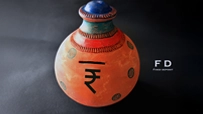How to Calculate Interest on Fixed Deposits: The Compounding Effect
September 09, 2025

Savings Accounts offer a safe gateway to park and grow your money. But, if you want to maximise your savings, switching to Fixed Deposits could be a smart financial move. Understanding how to calculate interest on Fixed Deposits may help you get an idea why FDs remain as an excellent investment instrument, specially for the long term.
In this blog, we have laid out the methods how Fixed Deposit interest is calculated. Let’s dive in!
Different Types of FD Interest Calculations
Fixed Deposits (FDs) are a popular investment choice due to their safety and predictable returns. There are two primary methods for FD interest calculation:
Simple Interest Method:
This method is easy to grasp and involves the following:
a) Formula: Principal x Rate of Interest x Time / 100
b) Example: For ₹1 lakh at an interest rate of 5% per annum for 3 years:
c) Calculation: ₹1,00,000 x 5 x 3 / 100 = ₹15,000
So, the interest amount is ₹15,000. The maturity amount would be
₹1,00,000 + ₹15,000 = ₹115000.
In the recent budget, TDS exemption limit on FD interest has been hiked to ₹50,000 for regular citizens and ₹1 lakh for senior citizens. The minimum TDS (Tax Deducted at Source) applicable is 10% on the interest earned if you provide PAN information and 20% if you don't provide PAN information.
However, the simple interest method is used primarily for non-cumulative FDs that come with periodic interest pay-outs. For cumulative FDs, where the interest is paid at the end of the tenure, the compound interest calculation method is used. And this where it gets interesting.
Compound Interest Method:
More complex to calculate but extremely useful when it comes to money matters, the compound interest method involves interest earning on the initial principal and on previously earned interest, meaning you earn interest on the accrued interest and principal amount when your FD gets reinvested. This helps in generating higher returns at the time of maturity.
a) Formula: P(1 + i/n)^(n*t)
Here P stands for the principal amount, i is the annual interest rate, n is the number of times interest applied per year, and t is the number of years.
b) Example: For ₹1 lakh at an interest rate of 5% per annum compounded annually for 3 years:
c) Calculation: ₹1,00,000 (1 + 0.05/1)^(1*3) = ₹1,15,762.50
So, you can clearly see the difference in the accumulated interest compared to the earlier example involving the simple interest calculation method.
Disclaimer: The above examples are for educational purposes only. Ujjivan SFB doesn’t take any responsibility regarding the accuracy of the information. For lates Ujjivan FD rates, please click here.
How Often is FD Interest Compounded?
The frequency of compounding for Fixed Deposits (FDs) typically falls into these categories:
a) Monthly: Interest is compounded every month. This means that each month’s interest is added to the principal, and the next month’s interest is calculated on the reinvested amount.
b) Quarterly: Interest is compounded every three months. The interest earned over a three-month period is added to the principal, and the next quarter’s interest is calculated on the amount.
c) Half-Yearly or at Maturity: Interest is compounded every six months. The interest accrued over six months is added to the principal, and the interest for the next six months is calculated on the amount.
d) Annually: Interest is compounded once a year. The annual interest is added to the principal, and the interest for the following year is calculated on the amount.
Please note that monthly interest pay-outs are for non-cumulative FDs. For cumulative FDs, the interest pay-outs happen at the end of tenure.
Disclaimer: The above compounding frequency is for generic information only. If you wish to invest in Ujjivan FD, for more details on compounding frequency, visit our website.
Online FD ROI Calculators may Help Calculate FD Interest Properly
Manual FD interest calculations can be taxing and may leave room for errors. As an alternative, you can use an online Fixed Deposit ROI Calculator. An FD calculator helps you calculate the interest along with the maturity amount in a matter of seconds. All you need to do is enter the details of your FD, including deposit amount, tenure, and interest pay-out frequency. Once done, you will be able to check your FD returns.
Benefits of Using Online Calculators
Using online calculators offers several advantages:
Final Thoughts
Fixed Deposits are reliable investments. They protect your money from market volatility. However, knowing how to calculate interest on Fixed Deposits can help you make better investment decisions. Use this knowledge to strategically plan and enhance your financial portfolio’s growth potential.
Looking to grow your savings? Ujjivan SFB offers a wide range of fixed deposit products. Select the FD of your choice and take a step forward to your financial goals. Alternatively, you can browse through Ujjivan SFB product suite - our wide range of financial products are designed to make your financial life better.
Disclaimer:
The contents herein are only for informational purposes and generic in nature. The content does not amount to an offer, invitation or solicitation of any kind to buy or sell, and are not intended to create any legal rights or obligations. This information is subject to updation, completion, amendment and verification without notice. The contents herein are also subject to other product-specific terms and conditions, as well as any applicable third-party terms and conditions, for which Ujjivan Small Finance Bank assumes no responsibility or liability.
Nothing contained herein is intended to constitute financial, investment, legal, tax, or any other professional advice or opinion. Please obtain professional advice before making investment or any other decisions. Any investment decisions that may be made by the you shall be at your own sole discretion, independent analysis and evaluation of the risks involved. The use of any information set out in this document is entirely at the user’s own risk. Ujjivan Small Finance Bank Limited makes no representation or warranty, express or implied, as to the accuracy and completeness for any information herein. The Bank disclaims any and all liability for any loss or damage (direct, indirect, consequential, or otherwise) incurred by you due to use of or due to investment, product application decisions made by you on the basis of the contents herein. While the information is prepared in good faith from sources deemed reliable (including public sources), the Bank disclaims any liability with respect to accuracy of information or any error or omission or any loss or damage incurred by anyone in reliance on the contents herein, in any manner whatsoever.
To know more about Ujjivan Small Finance Bank Products Visit:"https://www.ujjivansfb.in"
All intellectual property rights, including copyrights, trademarks, and other proprietary rights, pertaining to the content and materials displayed herein, belong
to Ujjivan Small Finance Bank Limited or its licensors. Unauthorised use or misuse of any intellectual property, or other content displayed herein is strictly prohibited and the same is not intended for distribution to, or use by, any person in any jurisdiction where such distribution or use would (by reason of that person’s nationality, residence or otherwise) be contrary to law or registration or would subject Ujjivan Small Finance Bank Limited or its affiliates to any licensing or registration requirements.
FAQs
1. What is a good rate for fixed deposits currently?
FD rates vary across banks. However, if you want to invest in high-interest FDs, you may consider investing in Ujjivan SFB Digital Fixed Deposit.
2. How does compounding frequency affect my total returns from an FD?
Higher frequency compounding results in higher returns as the accumulated interest itself earns interest.
3. Are there any tax implications with earnings from fixed deposits?
Yes, interest income from Fixed Deposits are taxable under 'Income from Other Sources’. The minimum TDS applicable is 10% only if the interest income earned in a financial year exceeds ₹50,000 for regular citizens and ₹1 lakh for senior citizens.
4. What is the minimum amount needed to open an FD?
The minimum amount required to open an FD with Ujjivan SFB is just ₹1,000.
5. Which forms should I submit to avoid TDS on FD?
Senior citizens can submit Form 15H and regular depositors can submit Form 15G to avoid TDS only if their income is below the minimum taxable limit.
Latest Blogs

Dussehra 2025: How to Win Your Financial Battles with Smart Saving
Dussehra 2025 (also known as Vijayadashami) falls on Thursday, October 2, 2025.

eSIM Scam in India: I4C Warns Mobile Users About Rising Fraud – How to Stay Safe
The Indian Cybercrime Coordination Centre (I4C), a wing of the Ministry of Home Affairs, issued a strong warning to mobile users about the rapid increase in eSIM fraud in India.

How to Link PAN with Aadhaar: Step-by-Step Guide & Consequences of Not Linking
Linking your Permanent Account Number (PAN) with your Aadhaar is no longer just a best practice.

Annual Information Statement (AIS): A Complete Guide for Stress-Free ITR Filing
India’s tax season is in its final stretch.

ITR-1 (Sahaj) Restrictions: Income Sources Not Allowed & Filing Rules
With just a few days left before the 15 September 2025 deadline for filing Income Tax Returns (ITRs) for Assessment Year (AY) 2025-26, many taxpayers are rushing to submit their forms online.





